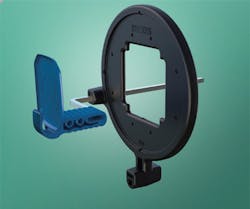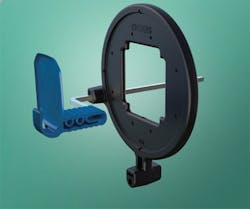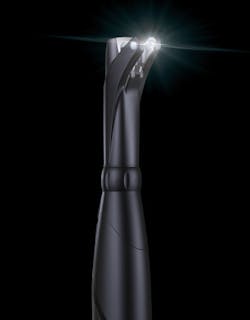DEXIS unveils and previews new products at Chicago Midwinter
DEXshield is a dental X-ray position indicating device and a patented patient protective shield. When used in conjunction with the DEXIS Platinum Sensor, this new device not only reduces radiation to the patient, it also aids in proper positioning for image capture. DEXIS is the only company to provide both an intraoral sensor, DEXIS Platinum, and a shielded ring, DEXshield, with the added benefit of dose reduction.
In a laboratory setting, DEXshield plus the DEXIS Platinum sensor was determined to reduce absorbed dose by at least 30% as compared to the Universal Ring plus the DEXIS Platinum sensor. During dental radiographic procedures, DEXshield’s tungsten core is able to block unnecessary X-rays. The resulting dose reduction does not affect image quality since the needed amount of radiation passes through the ring for optimal imaging results.
Maintaining the current DEXIS workflow, DEXshield takes the place of a standard ring. DEXshield was created to be easier to use than rectangular collimation, both of which were designed to reduce unnecessary dose to the patient. To overcome some of the limitations of rectangular collimation, DEXshield, when properly used with the DEXIS Platinum sensor, allows the operator to easily establish correct positioning and alignment. Appropriate positioning minimizes cone cuts which subsequently may reduce retakes that, in turn, potentially reduces even more unnecessary exposure.
DEXIS realizes that dose is important to dentists and their patients. Furthermore, the company recognizes that dental professionals want to control dose in an efficient manner while maintaining high image quality. Therefore, DEXIS has made dose control a priority in its device design goals. One result of this commitment was confirmed by developing DEXshield, which when combined with the DEXIS Platinum Sensor in recent laboratory testing, was determined to offer optimal results in imaging at a lower dose.
DEXshield Indications for Use: DEXshield is a dental X-ray position indicating device and a patient protective shield. It is intended for dental radiographic purposes to align the examination site with the X-ray beam and to protect the patient from unnecessary radiation exposure during radiologic procedures by providing an attenuating barrier to radiation.CariVu is a compact, portable caries detection device that uses patented transillumination technology. This new product provides the ability to easily detect a range of carious lesions (occlusal, interproximal, secondary/recurrent,) and cracks, and yields an easily interpreted image that is stored with the patient’s other images. Incorporating into current workflow, CariVu serves as a valuable adjunct tool for the identification of tooth decay when used with clinical and radiographic examinations.
CariVu embodies a modern version of transillumination technology that has been evolving for more than a decade and has been shown, in some cases, to find lesions earlier than with X-ray, as well as represent the lesion’s structure accurately. Also, design improvements have led to a product where the light source and other electronics needed for image capture are housed sleekly in a light-weight handpiece that can interact with the DEXIS software. The system also uses flexible, autoclavable tips. This improved usability speaks to the hallmarks of DEXIS imaging solutions of ease-of-use and patient comfort.
This new system employs near-infrared light which, in images, turns the natural tooth transparent and the caries dark similar to radiographs. Thus, it is in a view that is familiar to clinicians. Not only are CariVu images easy to read and understand, they are captured and stored with the patient’s other images. Since all intraoral X-rays, camera and CariVu images for the select tooth appear side-by-side, the clinician can quickly compare them to make a diagnosis and decide on a course of treatment. These images can be shared with patients so that they may better understand the need for preventive or restorative care.
The technology behind CariVu offers an advantage in diagnosis of caries as compared to systems that rely on fluorescence reactions which is typically denoted by colors or numeric values. In laboratory testing on the comparison of these two technologies, this new transillumination device showed that the view of the lesions on the images correlated well with their actual physical conditions. Thus, with CariVu, the dentist gains a more accurate view of the actual carious lesion’s shape and size, not just an indication of the presence of decay.
CariVu Indications for Use: The DEXIS CariVu is designed exclusively to support the identification of open or incipient carious lesions above the gingiva and for monitoring the progress of such lesions. Indications: Detection of smooth surface caries, detection of occlusal caries, detection of proximal caries, detection of initial caries, detection of secondary caries and detection of cracks.DEXIS is previewing its Mac product during the Chicago Dental Society’s Midwinter Meeting.
DEXIS Mac is a dental imaging solution that offers dentists a unified experience across Mac and iOS products. Once released, the native OS X software will provide clinicians with a highly efficient digital imaging workflow and seamless integration with Mac-based practice management programs Viive and MacPractice.
Dentists who have been looking for a native dental imaging software for the Mac will soon be able to enjoy the combination of this exciting new DEXIS release with the established user experience of Apple products. The DEXIS software will provide an intuitive user interface and advanced functionality that Mac users expect--combined with tried-and-true DEXIS image management and enhancement tools.
A tight integration between DEXIS Mac, the DEXIS go® app for patient communication, and the just-released DEXIS photo app for extraoral image acquisition is in the making as well. This should add more effectiveness for the Mac-based dentist. The apps collectively operate on iPad, iPhone, and iPod touch. Recognizing the fact that patient education and case presentation is important, DEXIS Mac will support Mac OS X full-screen mode and AirPlay mode for presenting on larger displays.
DEXIS Mac is scheduled to be formally introduced in Q2 of 2014.
For more information, visit www.dexis.com.
To comment on these products, go to http://community.pennwelldentalgroup.com.




